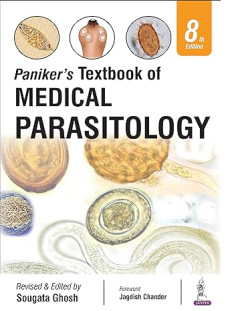Ditapis dengan

E-book Paniker’s Textbook of Medical Parasitology
• Written as per the latest curriculum of MBBS and MD (Microbiology) • Rearranges all the chapters in as sequential format and thoroughly updated and expanded to include new data • Adds the recent advances in each topic such as vaccine trials in Leishmania and Malaria, drug resistance in malaria. The new and fresh look reinvigorates the reading experience • Includes many new ph…
- Edisi
- Edisi 8
- ISBN/ISSN
- 9789352701865
- Deskripsi Fisik
- 271 halaman, ilus.
- Judul Seri
- -
- No. Panggil
- 616.96 GHO p
E-book Teknik Identifikasi dan Pemeriksaan Laboratorium Infeksi Kecacingan
- Edisi
- -
- ISBN/ISSN
- 9786027158825
- Deskripsi Fisik
- v, 79 halaman, 155 x 230 mm
- Judul Seri
- -
- No. Panggil
- 616.96 SUM t
- Edisi
- -
- ISBN/ISSN
- 9786027158825
- Deskripsi Fisik
- v, 79 halaman, 155 x 230 mm
- Judul Seri
- -
- No. Panggil
- 616.96 SUM t
E-book Parasitology
Parasitism is a widespread phenomenon in nature. The number of species of parasitic animals is about 7 % of the total number of animal species. The first scientific definition of the phenomenon of parasitism was given by R. Leucart in 1879. Parasitism is defined as a form of coexistence of organisms of different species, in which one organism (parasite) uses another (host) as a source of food a…
- Edisi
- -
- ISBN/ISSN
- 9785907209077
- Deskripsi Fisik
- 147 hlm
- Judul Seri
- -
- No. Panggil
- 616.96 VIK p
E-book Empire Under the Microscope : Parasitology and the British Literary Im…
Contemporary British parasitologist Frank Cox has explored how the question of what parasitology is has shaped the history of the discipline. Given that the parasitic lifestyle is common to helminths, bacteria, viruses, protozoa, fungi, parasitoid insects, some plants like mistletoe, and even birds like cuckoos, there is—and has historically been—a need to narrow down the subject …
- Edisi
- -
- ISBN/ISSN
- 9783030847173
- Deskripsi Fisik
- 303 hlm
- Judul Seri
- -
- No. Panggil
- 616.96 TAY e
 Karya Umum
Karya Umum  Filsafat
Filsafat  Agama
Agama  Ilmu-ilmu Sosial
Ilmu-ilmu Sosial  Bahasa
Bahasa  Ilmu-ilmu Murni
Ilmu-ilmu Murni  Ilmu-ilmu Terapan
Ilmu-ilmu Terapan  Kesenian, Hiburan, dan Olahraga
Kesenian, Hiburan, dan Olahraga  Kesusastraan
Kesusastraan  Geografi dan Sejarah
Geografi dan Sejarah